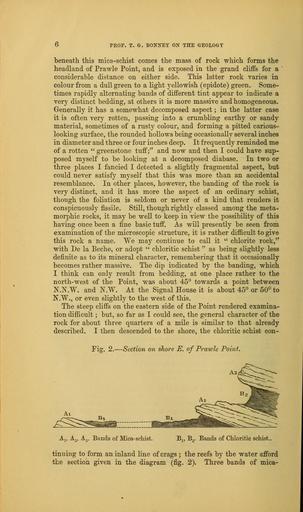MAKE A MEME
View Large Image

| View Original: | The_Quarterly_journal_of_the_Geological_Society_of_London_(14075753995).jpg (1234x2085) | |||
| Download: | Original | Medium | Small | Thumb |
| Courtesy of: | commons.wikimedia.org | More Like This | ||
| Keywords: The Quarterly journal of the Geological Society of London (14075753995).jpg 6 PROP T G BOIS'NEY OS THE GEOLOGY <br> beneath this mica-schist comes the mass of rock which forms the <br> headland of Prawle Point and is exposed in the grand cliffs for a <br> considerable distance on either side This latter rock varies in <br> colour from a dull green to a light j ellowish epidote green Some- <br> times rapidly alternating bands of different tint appear to indicate a <br> very distinct bedding at others it is more massive and homogeneous <br> Generally it has a somewhat decomposed aspect ; in the latter case <br> it is often Yery rotten passing into a crumbling earthy or sandy <br> material sometimes of a rusty colour and forming a pitted carious- <br> looking surface the rounded hollows being occasionally several inches <br> in diameter and three or four inches deep It frequently reminded me <br> of a rotten greenstone tuff; and now and then I could have sup- <br> posed myself to be looking at a decomposed diabase In two or <br> three places I fancied I detected a slightly fragmental aspect but <br> could never satisfy myself that this was more than an accidental <br> resemblance In other places however the banding of the rock is <br> very distinct and it has more the aspect of an ordinary schist <br> though the foliation is seldom or never of a kind that renders it <br> conspicuously fissile Still though rightly classed among the meta- <br> morphic rocks it may be well to keep in view the possibility of this <br> having once been a fine basic tuff As will presently be seen from <br> examination of the microscopic structure it is rather difficult to give <br> this rock a name We may continue to call it chlorite rock <br> with Le la Beche or adopt chloritic schist as being slightly less <br> definite as to its mineral character remembering that it occasionally <br> becomes rather massive The dip indicated by the banding which <br> I think can only result from bedding at one place rather to the <br> north-west of the Point was about 45┬░ towards a point between <br> N N W and N W At the Signal House it is about 45┬░ or 50┬░ to <br> Is' W or even slightly to the west of this <br> The steep cliffs on the eastern side of the Point rendered examina- <br> tion difficult ; but so far as I conld see the general character of the <br> rock for about three quarters of a mile is similar to that already <br> described I then descended to the shore the chloritic schist con- <br> Pig 2 ö Section on shore E of Prawle Point <br> Ap Ao A3 Bands of Mica- schist Bj B2 Bands of Chloritic schist <br> tinuing to form an inland line of crags ; the reefs by the water afford <br> the section given in the diagram fig 2 Three bands of mica- 36940767 113697 51125 Page 6 Text 40 http //www biodiversitylibrary org/page/36940767 1884 Geological Society of London Biodiversity Heritage Library The Quarterly journal of the Geological Society of London v 40 1884 Geology Periodicals Smithsonian Libraries bhl page 36940767 dc identifier http //biodiversitylibrary org/page/36940767 smithsonian libraries Information field Flickr posted date ISOdate 2014-04-30 Check categories 2015 August 26 CC-BY-2 0 BioDivLibrary https //flickr com/photos/61021753 N02/14075753995 2015-08-26 05 54 10 cc-by-2 0 PD-old-70-1923 The Quarterly journal of the Geological Society of London 1884 Photos uploaded from Flickr by F├” using a script | ||||